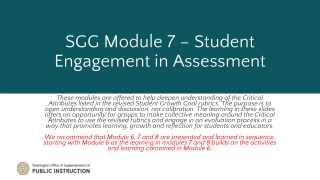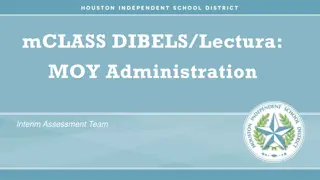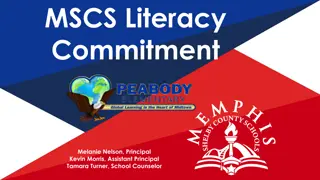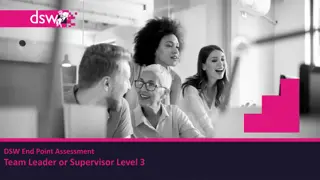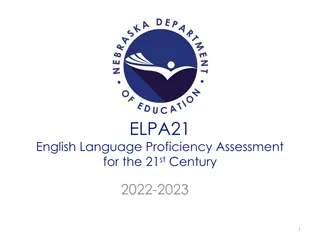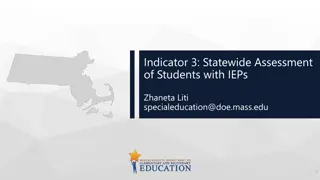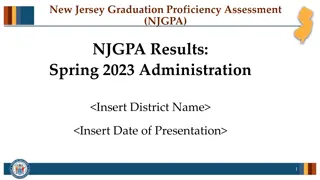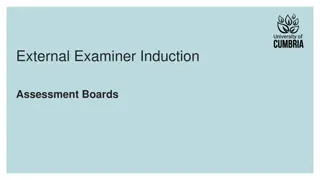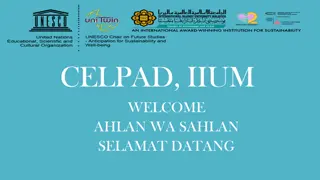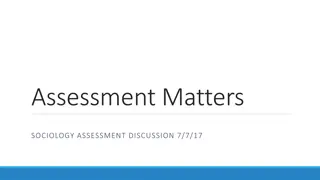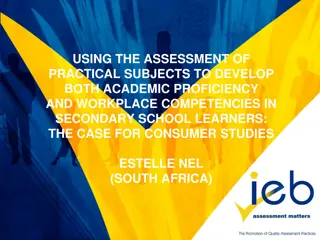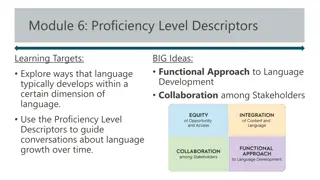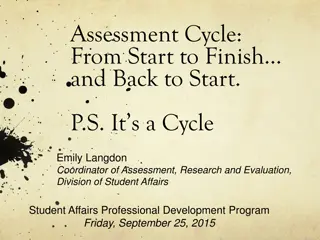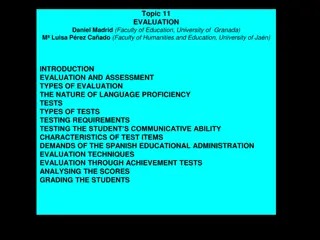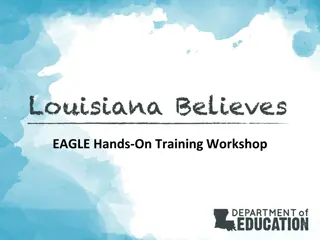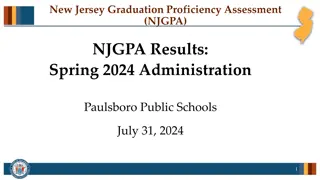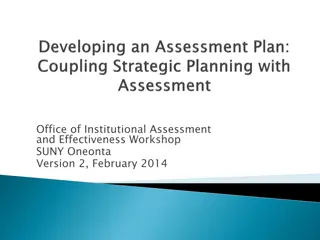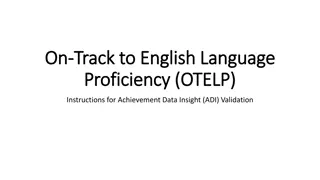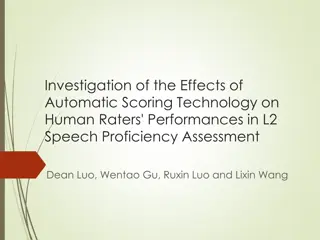Assessment Strategies for Student Proficiency
Use of ChecBrics in assessing knowledge-in-use, providing actionable feedback, and clarifying performance expectations for students. Understand the differences between rubrics and ChecBrics as assessment tools and learn how to create effective learning environments through assessment.
Download Presentation

Please find below an Image/Link to download the presentation.
The content on the website is provided AS IS for your information and personal use only. It may not be sold, licensed, or shared on other websites without obtaining consent from the author. Download presentation by click this link. If you encounter any issues during the download, it is possible that the publisher has removed the file from their server.
E N D
Presentation Transcript
Knowledge is Not a Checklist: Assessing Knowledge-in-Use THERE S MORE THAN ONE RIGHT ANSWER TO MANY PERFORMANCE TASK ASSESSMENTS! LEARN HOW TO USE CHECBRICS TO ELICIT STRONG EVIDENCE OF STUDENT PROFICIENCY.
Introductions Introductions STEM Instructional Coach Lake Orion Community Schools Science Education Consultant Oakland Schools Curriculum & Instructional Specialist Troy Public Schools amy.bohm@lok12.org @AmyBohm erokicki@troy.k12.mi.us thistooistrue@EvanRokicki jessica.ashley@oakland.k12.mi.us @joy_everyday
Outcomes Outcomes Identify differences between rubrics and ChecBrics as assessment tools Clarify expectations of performance for students without giving the answer away Learn to provide actionable feedback to improve student performance
Agenda Agenda Why ChecBrics? Characteristics of ChecBrics Examples of using ChecBrics to assess knowledge in use: Math / Science / & ELA Contextualized Rubrics Extended Formative Assessment & Historical Thinking Reflection: Monday or Someday....
...teachers must fashion intermediate goals that can serve as an effective route to achieving the externally mandated goals, and to do so effectively, they must have an understanding of how students represent knowledge and develop competence in the domain. ~James W. Pellegrino, 2014 ...the target knowledge at any given grade level may well involve an incomplete or intermediate understanding of the topic or practice...There are acceptable steppingstones on the pathways students travel between naive conceptions and scientists best current understandings. (NRC 2014, p 37.) The teacher s job is not to transmit knowledge, nor to facilitate learning. It is to engineer effective learning environments for the students. The key features of effective learning environments are that they create student engagement and allow teachers, learners, and their peers to ensure that the learning is proceeding in the intended direction. The only way we can do this is through assessment. That is why assessment is, indeed, the bridge between teaching and learning. ~ Dylan Wiliam, Embedded Formative Assessment The quality of any assessment depends first and foremost on the clarity and appropriateness of our definition of the achievement target to be assessed. ~Rick Stiggins Why ChecBrics? Why ChecBrics?
What are What are ChecBrics ChecBrics? ? A ChecBric is a combined checklist andscoring rubric. It highlights the presence or absence of a trait or required element and allows scoring of the quality of the element (Lewin, 1998, p. 135) A ChecBric is, in essence, a contextualizedrubric
Characteristics of a ChecBric Characteristics of a ChecBric A ChecBric . A ChecBric is not a(n) . Scaffolds outcomes in accessible language Supports ALL students / All Levels Helps students be self-starters Provides cues about what is significant in a student response Assists in student planning / goal setting Helps provide actionable feedback Self-Assessment & Student Growth Pure Evaluation Tool Exhaustive Checklist of Criteria Combination of performance criteria with format expectations
Introduction to Tasks & Documents Introduction to Tasks & Documents Read Individually read the student work sample --- top to bottom. Score Individually score the task. Share your scoring results with your partner. Explain your thinking. Share Discuss Discuss discrepancies, reach a resolution.
The Tasks... The Tasks... Grade 5 Science High School Social Studies Grade 4 Math
Scoring & Dialogue Scoring & Dialogue Read Individually read the student work sample --- top to bottom. Score Individually score the task. Share Share your scoring results with your partner. Explain your thinking. Discuss Discuss discrepancies, reach a resolution.
Grade 4 Math Veggie Pizzas Veggie Pizzas The content standard is 4.NF.2: The practice standards (SMPs): Compare two fractions with different numerators and different denominators, e.g., by creating common denominators or numerators, or by comparing to a benchmark fraction such as 1/2. Recognize that comparisons are valid only when the two fractions refer to the same whole. Record the results of comparisons with symbols >, =, or <, and justify the conclusions, e.g., by using a visual fraction model. SMP.1 Make sense of problems and persevere in solving them. SMP.4 Model with mathematics.
Student Checklist Student Checklist Teacher Rubric Teacher Rubric Make comparisons between fractions with different numerators and different denominators Use symbols to record comparisons between fractions Use models to make thinking visible to solve problems Use multiple models to show perseverance in solving problems Compare two fractions with different numerators and different denominators Common denominators Common numerators Comparisons are valid only when two fractions refer to the same whole. Record the results of comparisons with symbols >, =, or < Justify the conclusions, e.g., by using a visual fraction model. Use multiple models to show perseverance in problem solving Grade 4 Math
How can people minimize the effects How can people minimize the effects of zebra mussels on lakes? of zebra mussels on lakes? Performance Expectations Targeted in Cycle 1 5-ESS2-1. Develop a model using an example to describe ways the geosphere, biosphere, hydrosphere, and/or atmosphere interact. 5-ESS3-1. Obtain and combine information about ways individual communities use science ideas to protect the earth s resources and environment. 3-5-ETS1-2. Generate and compare multiple possible solutions to a problem based on how well each is likely to meet the criteria and constraints of the problem. Grade 5 Science
Grade 5 Science But .this takes time! But .this takes time!
Grade 5 Science Integrating Science & ELA Integrating Science & ELA Reading, Writing, Speaking, & Listening Math Science Specials Social Studies Literacy
Lucy Calkins Opinion Writing Rubric Grade 5 Science
What What connections connections are you making? are you making? What What challenges challenges are you noticing? are you noticing? . With the ChecBrics . With the sample student work . With the writing rubric
But... performance But... performance tasks take time, and tasks take time, and what is considered a what is considered a good performance good performance task? task? James W. Pellegrino International Association for Educational Assessment Pg. 12 Singapore, 2014
Are there other options? Are there other options? What about assessing student knowledge and skills prior to a performance assessment, e.g. formative assessment? What about disciplinary thinking in the sciences and social studies? Formative Assessment Cycle: Applies to all Subject Areas
High School Social Studies Contextualized Rubrics & Disciplinary Contextualized Rubrics & Disciplinary Thinking Thinking When we recognize that true understanding of a discipline involves learning its processes and ways of thinking as well as its content knowledge, then we naturally create opportunities for developing those abilities. The complex cognitive processes used by experts in the field to reason about the past. Sourcing Contextualizing Corroborating ~Cultures of Thinking, Ritchhart, Pg. 75 (2015)
High School Social Studies Document 4 is the least useful source in our inquiry because A. it was created by a political cartoonist B. it presents an interpretation, not evidence C. it was created after the assassination D. it shows President Kennedy s remorse Doc 1 Diplomatic Cable Doc 2 Telephone Transcript Doc 3 Conference Memorandum Doc 4 Political Cartoon Weighted Multiple Choice To what extent was Kennedy responsible for the coup that killed Ngo Dinh Diem ?
We dont learn from our experiences, we We don t learn from our experiences, we learn by processing our experiences. learn by processing our experiences. - - Carolyn McKanders, Adaptive Schools & Cognitive Coaching Carolyn McKanders, Adaptive Schools & Cognitive Coaching Monday . I will do / try... & Someday I will do / try...
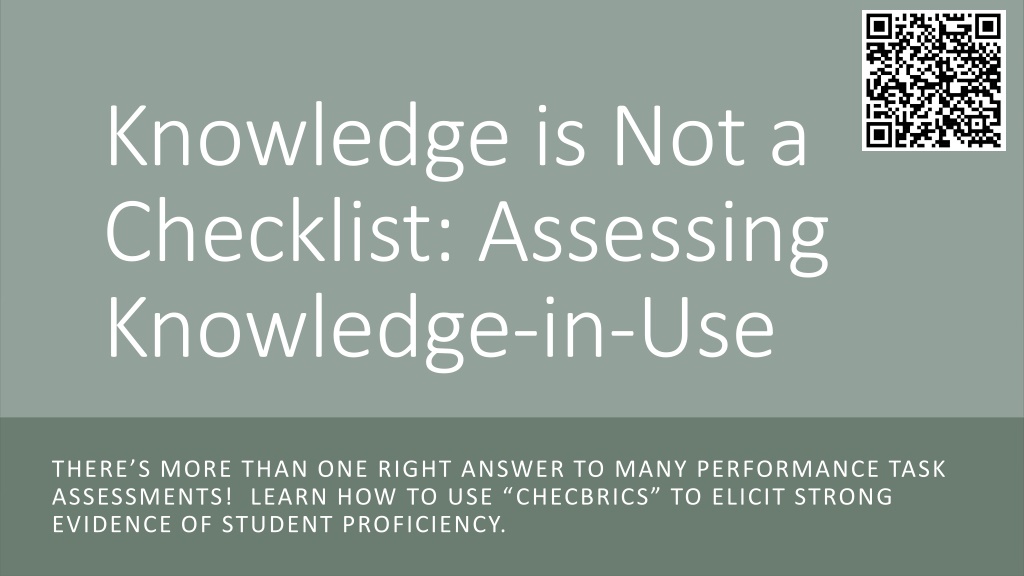
 undefined
undefined














